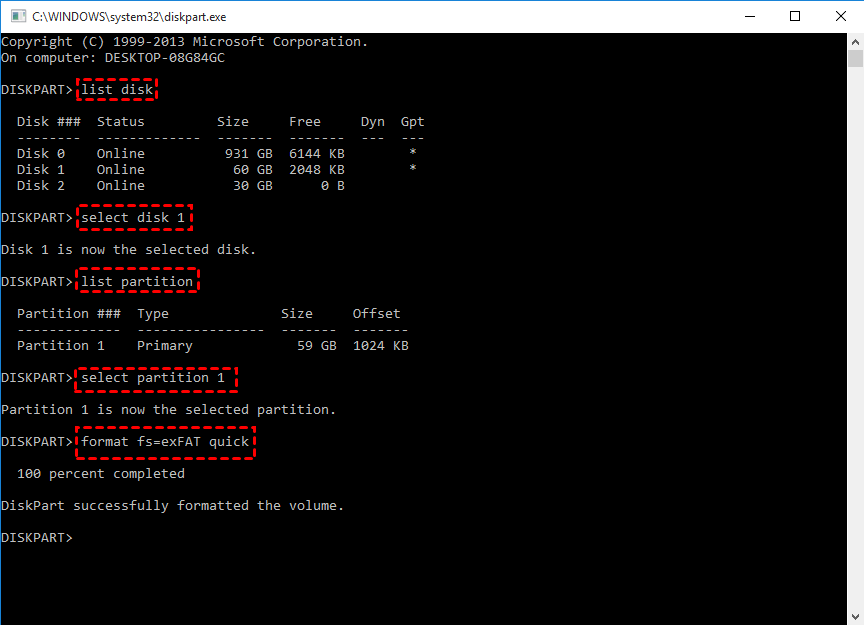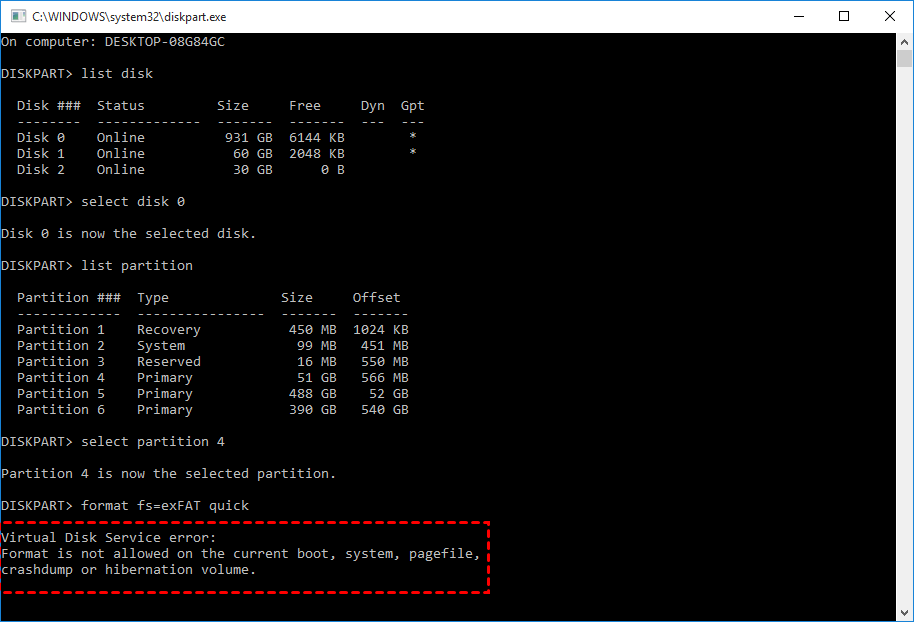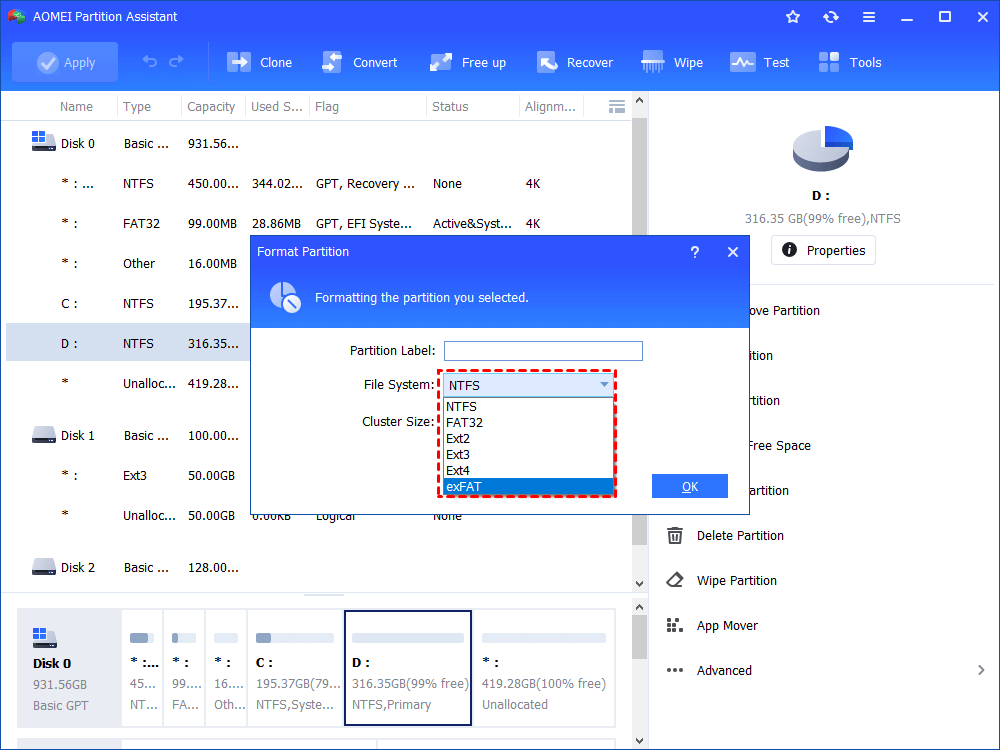Diskpart: Format Disk to exFAT via Command Line in Windows PC
Need to format disk to exFAT in Windows 10/8/7? Read this article and find an effective and easy method to format disk to exFAT.
Why format hard drive to exFAT?
exFAT is one of file systems that are a way of organizing data on a storage device like hard drive, USB flash drive. exFAT was designed to a lightweight file system like FAT32. And it also comes with good compatibility like FAT32 file system. It is supported in Windows XP/11/10/8/7 systems, and it can be used in Mac OS X and most cameras, phones, PlayStation 4 and Xbox One.
And it doesn't have the limitation of FAT32 that a file can't over 4GB. So, if a FAT32 hard drive tells you a file is too large like the scenario, you can using diskpart to format the hard drive to exFAT.
How to format external disk to exFAT using diskpart?
If you are familiar with Command line, you can use the diskpart to format a hard drive, SD card, and USB drive to exFAT file system. Just connect your disk with a Windows computer and follow the steps:
Step 1. Press “Win + R” to open Run Box and type “CMD” in the box to run Command Prompt.
Step 2. Type “diskpart” to open diskpart window.
Step 3. Run the following commands in diskpart windows. Remember press Enter after typing each one.
● list disk
● select disk n (n is the drive letter of the external disk)
● list partition
● select partition x(x means the partition you want to format to exFAT)
● format fs=exFAT quick
Step 4. When the “DiskPart successfully formatted the volume” appears on the screen, and type “exit” to leave the Diskpart.
Alternative to Diskpart: format internal and external disk to exFAT
Diskpart can effectively format an external disk, but when it formats an internal disk or partition, it will note that “Format is not allowed on the disk containing the current boot, system, pagefile, crashdump or hibernation volume”.
Moreover, for most computer users, it is sorts of troublesome to remember these commands, and they would feel confused once they mistype one command. Is there an easier way to format internal and external disk to exFAT in Windows10/8/7?
Yes, there is a freeware called AOMEI Partition Assistant Standard that can format a disk, SD card, USB drive to exFAT, NTFS, FAT32, and Ext2/3/4 file systems to meet different demands. And by its intuitive interface, you can finish the operation in a few clicks. Just click the following button to download AOMEI Partition Assistant and follow the tutorial.
Step 1. Insert the disk you want to format to exFAT, and open AOMEI Partition Assistant, right-click the drive, and select “Format partition”.
Step 2. Choose “exFAT” from the drop-down menu, and click “OK”.
Step 3. In the main interface, click “Apply” > “Proceed” to start formatting the drive to exFAT file system.
Conclusion
I hope these 2 methods can help you to solve your problem. You can choose them according to your preference. If you prefer command line, you can format an external disk to exFAT with Diskpart, otherwise, Method 2-AOMEI Partition Assistant is more recommended, because it is very easy to operate, and it can format both internal and external disk to exFAT.
Besides, you can upgrade to Professional edition to have more functions such as DOD wiping hard drive to clear a disk thoroughly, and if you're using an MBR disk as the system disk and you want to upgrade to Windows 11, you can use this software to convert system disk between MBR and GPT partition styles, change dynamic disk to basic disk.
Additional Content: other file systems
Besides exFAT, NTFS and FAT32 are 2 other file sysetms that used by most of storage devices. Here are the brief introduction of them.
● FAT32 owns so good compatibility that it can be read/write in many systems. But formatting a disk to FAT32 makes it be unable to keep any files larger than 4GB. That is the reason why the user would be told his/her file is too large for the destination file system.
● NTFS file system can contain individual files more than 4GB and shows a good edge in data security; it provides “shadow copy” to help quickly recover errors if your computer crashes, so it is used widely by Windows internal hard drive. However, NTFS has limited compatibility. It can work with Windows XP and later versions, but it can be read-only by Mac OS X and doesn’t support PlayStation.
Q&A
『Can Windows format a disk to exFAT file system?』
Yes, but only for external storage devices, like USB drive, SD card. And you will not be offered the “exFAT” file system when formatting an internal hard drive in Disk Management and Windows File Explorer. So formatting a disk with AOMEI Partition Assistant can be the better choice because you can format both internal and external disk to exFAT, FAT32, NTFS, and other file systems.
But one thing you should note: all Windows native formatting tools (Disk Management, File Explorer and Diskpart) cannot format over 32 GB hard drives to FAT32. AOMEI Partition Assistant Standard breaks the limit and is able to format large hard drive to FAT32 with ease.
『Can windows 10 read exFAT drives?』
Yes, it can. Windows 10 supports many file systems, and exFAT is one of them. But if you format your drive to exFAT with Apple’s HFS Plus, the drive cannot be recognized by Windows 10, although exFAT can be recognized by either Windows 10 or ISO.
『Does exFAT better than FAT32 or NTFS?』
You should choose a file system according to its features and your actual conditions. For example, the scenario at the beginning of this post, exFAT is the best choice in consideration of compatibility and storage capacity.




